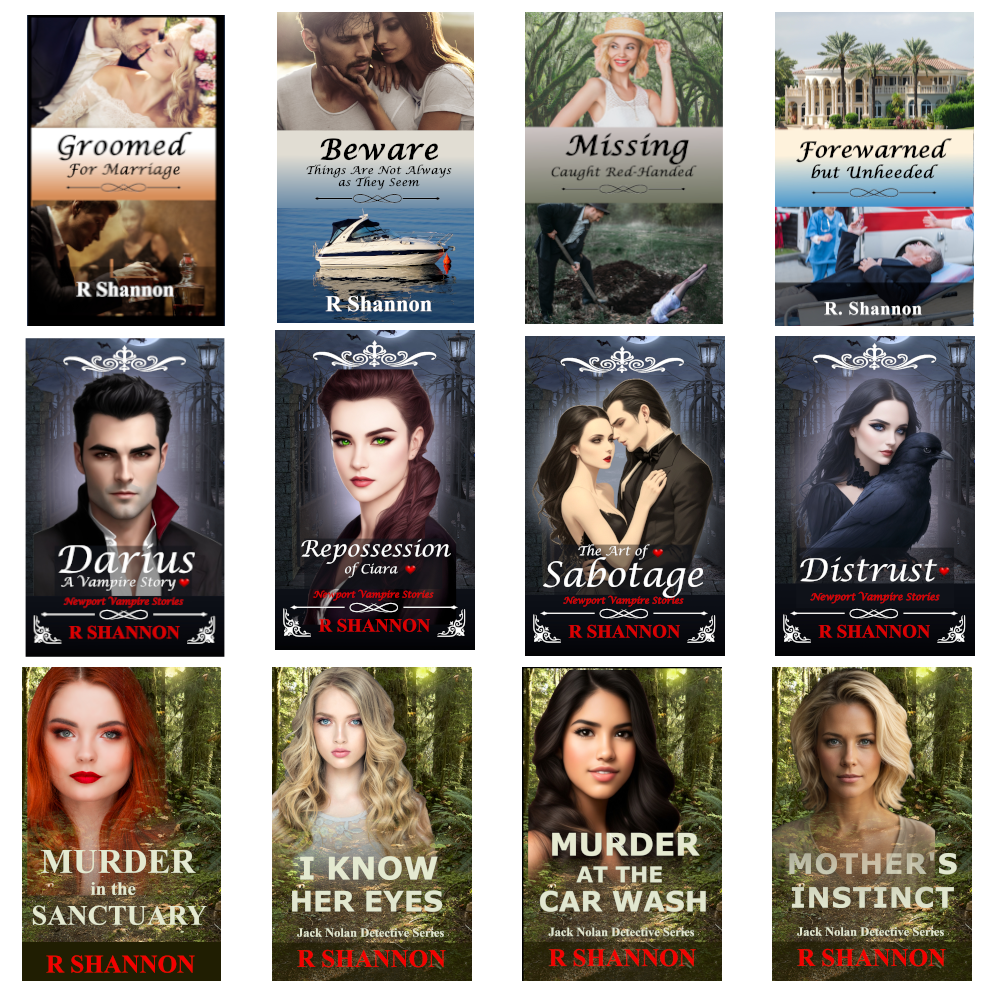I ACCIDENTALLY WROTE MY FIRST BOOK SERIES:
 I didn’t set off to write a book series. How did it happen? My first novel turned out to be way too long and there was way too much going on. So I broke it down and wrote two separate stories.
I didn’t set off to write a book series. How did it happen? My first novel turned out to be way too long and there was way too much going on. So I broke it down and wrote two separate stories.
Once I finished the first two novels, I realized that because my main character was a private investigator, it was possible to continue to solve crimes in new books, so that’s what I did. The series is now four books, but I could easily add more in the future.
During the process of writing my first, second and third series, I learned a lot of tips to make it easier. There were so many things I didn’t know I didn’t know in the beginning. My purpose in this blog post is to pass on my best tips in writing a book series.
 I found out later that more experienced authors even suggested that newer authors consider writing in series because it’s easier to market the books. But my venture into writing book series was a happy accident.
I found out later that more experienced authors even suggested that newer authors consider writing in series because it’s easier to market the books. But my venture into writing book series was a happy accident.
TIP NUMBER 1: KEEP A LONG RUNNING INFORMATION LIST
Keep a long running names list. I call mine an Information Sheet. I put down every character I ever name. I learned the hard way to only trust my memory. It doesn’t work!
By having a long list of every character, street names, crime locations, neighbor names, job titles, etc., you will have all of this information at your fingertips.
Example Number 1: In my first novel in the Jack Nolan Detective Series, I needed an immediate boss’ name. So I chose Lieutenant Duane White. But then when I needed to refer to him in Book 3 but I forgot what I named him! I had to hunt him down in the manuscript of the first book. This can take hours, especially if you don’t have any clue what you may have called him.
Now I keep the all proper names and other information that I may need again on a long list that travels with me through each book. No matter how insignificant the character seems, I write it down on my information list.

Example Number 2: I referred to Jack Nolan’s wife, one of the characters, as having left him eight month’s previous to the start of the series. By having this information recorded, I was able to track how many months passed and how this time increased over the time of the series.
Example Number 3: Town names, Plaza names, Mall names, etc. All of these seem insignificant when you are pulling the names out of the air during the drafting of the book. But with cops working in the same town, you may need to reference that same mall again.
Special Note to Fantasy Writers: They use what they sometimes call a World Bible, and this is a more extended information list. It’s important to keep track of everything I’ve just mentioned, as well as the world rules and the rules regarding whatever supernatural power you may write about.
TIP NUMBER 2: KEEP A SHARED MARKETING LIST FOR THE ENTIRE SERIES:

Keep all of information about the books on one shared marketing sheet. I keep the names, publication dates, book links, categories, and keywords for the books all on one page.
Once you begin to market the books, you will need to use this information over and over again.
You may also want to keep a few short blurbs because when uploading to advertise on Bookfunnel, Bookbub, FussyLibrarian, or Freebooksy, you will need all of this information handy.
At the time of the writing of this blog post, Amazon only allow an author to put their book in 3 genres. If you have 4 books in a series, you can put the last three books in different genres thereby extending your marketing reach.
It goes without saying that you should have a link in the back of each eBook so the reader can click on the link and go to purchase the next book inthe series.
Amazon only allows seven keywords for each book. Use the best keywords for the first book or two. Then use longer-tail keywords and different keywords to broaden your reach for new readers. By having them handy, especially if you do keyword research, it will make all of this much easier.
Let me give you an example: In my Jack Nolan Detective Series, I put the first book into Police Procedurals, Mystery Romance, and Mystery Suspense. But Books 2 to 5, I can add into general mystery categories and women’s fiction, literature and fiction, etc. You can imagine how much broader your reach for new readers will be.
TIP NUMBER 3: USE A BROAD STROKE CHARACTER ARC OVER THE ENTIRE SERIES:
 I use broad-stroke character arc for the main characters that extends over all the books in the series. Each individual book, however, the character grows and changes a little bit. So each book contains its own arc, but there is a longer series arc for the main characters. It helps to know this before you start writing the series.
I use broad-stroke character arc for the main characters that extends over all the books in the series. Each individual book, however, the character grows and changes a little bit. So each book contains its own arc, but there is a longer series arc for the main characters. It helps to know this before you start writing the series.
Each book has a crime or mystery that plays out and is solved. The characters grow during the subplot of each book. Once the mystery is solved, a new normal is shown with the characters embracing their new-found growth. In the next book, the same template will be followed. The mystery or crime will play out or be solved, and characters will grow, and there will be a new normal that reflects that growth.
TIP NUMBER 4: I WRITE THE BOOKS AS STAND-ALONE BOOKS
This tip is about writing the books in the series as ‘stand-alone books’. This allows me to market the books as a series, but also as stand-alone books. As stated above, each book has a full plot that completes but I put in enough background information in order to fill in stand-alone readers on what is going on with the characters in case they haven’t read the initial books.
I write in Scrivener and I set up a meta tag so I can keep track of what background information I need to drop into the story for those stand-alone readers. This makes marketing the books much easier.
